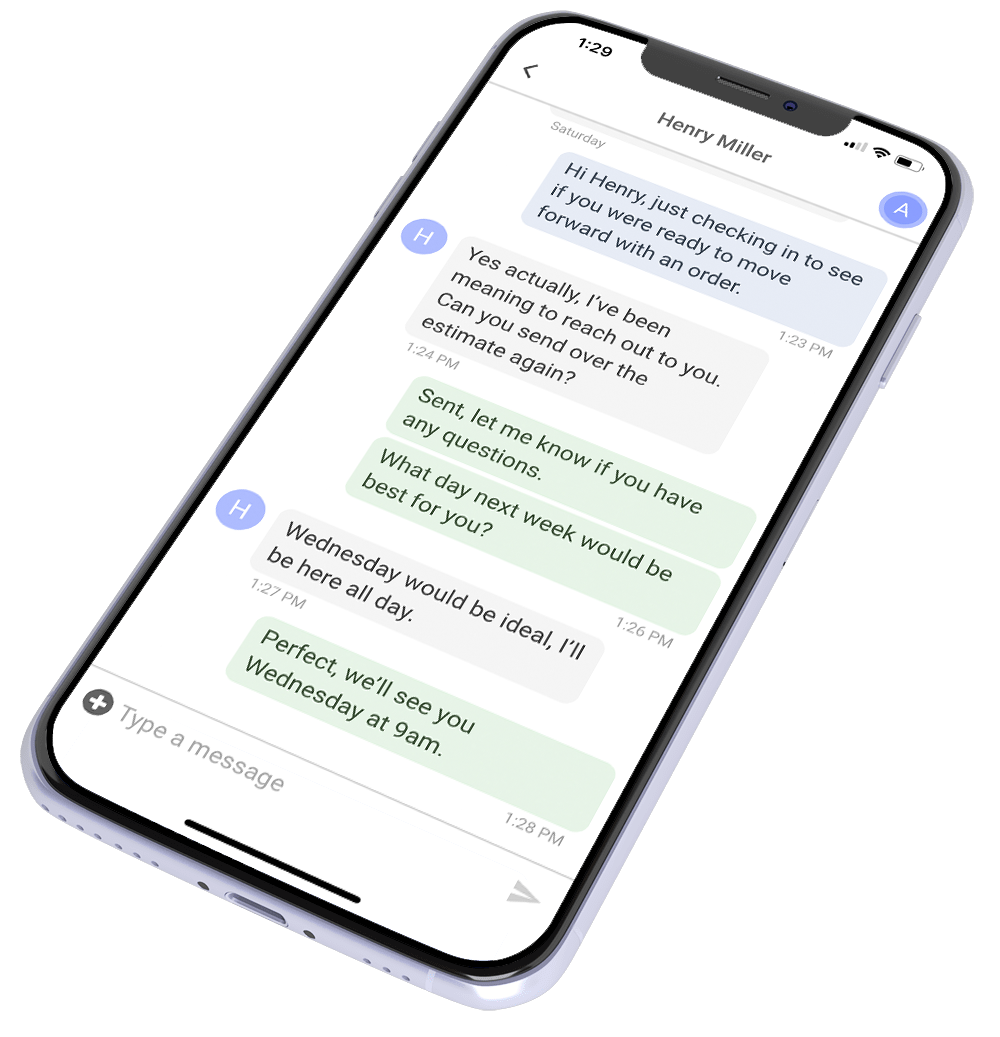AI roofing software helps you sell more jobs, faster by doing the work most roofers forget, skip, or hate.
You can’t swing a cat in 2025 without hitting some so-called revolutionary AI software. But this isn’t the first time we’ve seen a tech trend take over. Back in the late ’90s, everyone tacked “.com” onto their name like it meant something. Then came social media, Big Data, and the crypto boom—Bitcoin, blockchain, NFTs, and all that mess. So yeah, it makes sense that AI is the next big thing, and now everyone’s pretending to be “AI-first.” We get it. We roll our eyes too.
The real difference with AI, though, is that it’s not new. It’s actually been around for a long time just under different names, like machine learning. What’s different now is that AI shows real promise. It can make people more productive. It can help you get a lot more done, faster.
The numbers show it. One global market report estimates the AI in construction market at about $3.93 billion in 2024, projected to grow to about $22.68 billion by 2032 (roughly 25% yearly growth).
Are we in an AI bubble? Maybe. Time will tell. It wouldn’t be the first time a new tech wave got hyped beyond belief. Right now, sure, a lot of the promises feel inflated. But once the dust settles, we probably won’t go back to life before AI.
That’s why you don’t want to wait. If you ignore it, there’s a real chance your competitors will leave you in the dust. But here’s where it gets tricky. There’s a big difference between adopting AI just to say you did, and adopting it in a way that actually helps your business. Take Klarna, for example. They tried to go all-in on AI and had to walk it back when it just couldn’t deliver. That’s the danger of chasing hype instead of solving real problems.
So how do you find the balance? How do you tell what’s useful from what’s just noise? That’s what this article is about. We’re going to walk through five ways AI tools can actually help you sell more roofs. Plus, we’ll show you a few roofing software options you can try today.
Sound good? Let’s dive in.

What the Heck Is AI Roofing Software?
Nobody wants to rain on the AI parade. It’s a buzzword, sure, but one that actually seems to increase the value of a company just by association. Say you’re working with AI, and suddenly your business sounds smarter, faster, and more cutting-edge. But the truth is, AI has been around for decades. Back in the day, we called it machine learning, and it powered everything from agriculture to defense to data crunching.
What really changed things was 2022. That’s when tools like ChatGPT introduced the world to something called large language models, or LLMs. These tools let anyone type in a prompt and get back a full-blown response. That’s a big shift. Unlike expensive, proprietary software built for narrow use cases, LLMs were free, fast, and available to everyone. And more importantly, they felt like actual intelligence. You could talk to them. That’s what people imagined when they pictured AI.
Now, whether it’s really intelligence is something academics love to argue about, but that doesn’t matter here. What matters is that it sparked a wildfire. Suddenly, AI wasn’t just for tech nerds or billion-dollar industries. It was something regular folks could use.
For this article, though, we’re not just talking about chatbots that write your emails. That’s just one small part of AI. We’re looking at roofing-specific applications. Tools like EagleView, for example, use AI to scan aerial imagery, detect wind damage, and measure roofs with crazy accuracy. That’s machine learning in action. Or take software that figures out the best time to send a follow-up text. Again, that’s AI. The system learns from data to make smart decisions that help you close more jobs.
AI roofing software uses artificial intelligence to measure roofs, detect damage, automate follow-up, analyze sales data, and summarize calls. Roofers use these tools to quote faster, respond to leads instantly, and close more jobs without adding more staff.
With that in mind, let’s break down the best ways to use AI in your roofing business and highlight a few tools worth checking out.
1. Aerial Measurements and Inspections
This one’s obvious but still worth calling out. Most roofers already use this tech without realizing it’s powered by AI. Every time you order an EagleView report or a GAF QuickMeasure, you’re using artificial intelligence. Those tools pull aerial or satellite images and then calculate measurements with scary precision. The same goes for roof inspections that detect hail damage or wear. That’s AI, plain and simple.
But the question isn’t whether this tech exists. The question is: how do you actually use it to make more money? Some roofers are even trying full-remote models. They order the EagleView, build the quote, and send it over by email or text. No site visit, no handshake. That might sound slick, but there’s a catch. Roofing is still a trust game. And trust comes easier when you meet face to face.
So here’s the smart move. Before you ever inspect a roof, pull the EagleView. Get all your measurements ahead of time. Use AI to detect damage if you can’t spot it yourself. Then, walk into the appointment with everything ready. Build the quote while you’re still standing in the driveway. Hand it to the homeowner right there.
That speed gives you a serious edge. If you’re the first roofer to deliver a quote, you’re often the one who gets the job. Showing up prepared with exact measurements and a ready-to-go estimate can win deals before your competitors even respond. That alone makes aerial AI tools worth every penny.
AI Roofing Software Worth Checking Out
EagleView
EagleView is the gold standard in aerial measurements. It uses advanced imagery and machine learning to deliver ultra-precise roof reports, often down to a fraction of an inch. Whether you’re measuring steep slopes, complex layouts, or storm damage, EagleView’s automation does the work without sending a rep on-site. Many roofers use this to build quotes before ever stepping on a ladder.
GAF QuickMeasure
This is a fast, no-fuss option built by one of the biggest names in roofing. GAF QuickMeasure delivers full roof measurement reports in under an hour for most single-family homes. The reports include interactive 3D models and full measurements, making them easy to plug into your quoting process.
Hover
Hover combines AI with smartphone photos or drone footage to turn any home into a fully measured, 3D model. It’s extremely visual, which is great for both quoting and homeowner presentations. You can also integrate the data directly into estimating software, streamlining your process from photos to final price.
👉 hover.to
RoofScope
RoofScope uses high-res aerial imagery and CAD verification to deliver 99% accuracy in roof reports. It’s especially useful for larger or more complex jobs, including multi-family and commercial. Contractors often rely on RoofScope to win jobs where precision and professionalism matter.
2. Instant Follow-Up and Automated Follow-Up
When homeowners compare two roofing companies, better communication is the top deciding factor for about two-thirds of them, according to Roofing Contractor’s 2025 Homeowners Survey sponsored by Owens Corning and Roofle Technologies.
We know this is ProLine’s bread and butter. So, of course, we’re going to talk about automated follow-up. But ProLine has evolved way beyond simple “if this, then that” logic. With our AI Agents, you’re looking at technology that can actually answer calls, qualify leads, and book inspections 24/7 without you lifting a finger.
ProLine’s AI-powered automation engine can handle the entire front end of your sales process. When a lead comes in, agents can have an actual conversation, answer questions, and get that inspection on the calendar. And if someone doesn’t respond, ProLine keeps following up with texts and emails on whatever schedule you set: two hours later, a day later, a week later.
You still customize the messaging and set the rules. A lot of ProLine users even use ChatGPT to craft their initial templates. But once you’ve got the system dialed in, it runs itself. And unlike your sales reps, it never gets distracted, never forgets, and never stops following up.
This has two massive benefits. First, it speeds up your response time to nearly instant. Leads come in at 11 PM, and they’re getting a response immediately. No waiting until your rep rolls into the office. Second, it extends your follow-up window far beyond what any human could maintain. Reps chase hot deals and forget about older leads. ProLine’s AI doesn’t.
AI Roofing Software Worth Checking Out
ProLine
ProLine is built around an AI-powered business automation engine that handles calls, texts, and emails from the moment a lead enters your pipeline. ProLine’s AI Agents answer every call, qualify leads in real-time, and book inspections around the clock. You customize the workflows and messaging to sound exactly like your team, but the AI handles the heavy lifting. Whether you need instant responses to web leads, persistent follow-up on quotes, or automated reminders for no-shows, ProLine runs it all in the background. You stay in control. Your leads get fast, professional responses. And you never miss another opportunity because someone called after hours or your rep was on a roof.
👉 useproline.com
3. AI Data Analysis
By now, you’ve probably noticed that AI has a few blind spots. For example, try telling ChatGPT to stop using em dashes. You can yell at it until the cows come home—it’ll sneak them in anyway (see what we did there?). It’ll also make up facts with total confidence, which is just plain dangerous if you’re not double-checking things. But one thing AI is great at? Crunching data.
Let’s say you’ve got a mountain of sales info and no clue what to do with it. AI tools like ChatGPT can help. You can upload spreadsheets and ask it to sort, analyze, and surface insights. The more specific your questions, the better your results. At ProLine, we’ve used it to figure out which of our videos perform best, based on engaged views, swipe-away rates, and watch time. It helps us double down on what’s working and cut what’s not.
Another killer use case is sentiment analysis. Some AI tools, including ChatGPT and Otter.ai, can read transcripts from calls or messages and figure out how people felt during those conversations. Happy, annoyed, confused, it tags the tone and emotion behind the words. This can be especially powerful if you use a CRM like ProLine that stores texts and call recordings. You can feed that data into AI, and it’ll show you patterns across your customer base.
One bad review or grumpy call transcript isn’t a big deal. But when you zoom out and analyze a bunch of them, trends start to show up. Maybe all your frustrated customers came through the same marketing campaign. Maybe they all dropped off at the same stage. That kind of insight can change how you qualify leads, how you follow up, and how you train your team.
AI Roofing Software Worth Checking Out
ChatGPT
ChatGPT makes it dead simple to analyze spreadsheets and sales data, even if you’re not a numbers person. Upload your data, ask pointed questions, and let it surface trends, summaries, and anomalies. It’s not a full analytics platform, but it works fast, gives readable answers, and helps you make sense of messy data without needing a data science degree.
👉 chat.openai.com
Julius AI
Julius is like ChatGPT with a spreadsheet obsession. It connects to your Google Sheets or Excel files and lets you query them in plain English—”What was our close rate last quarter?” or “Which rep had the highest deal size?” It’s purpose-built for business data analysis, which makes it a great companion when you want AI to do more than just write emails.
👉 julius.ai
4. Transcribing and Note Taking
We’ve already talked about how AI isn’t always the best writer. ChatGPT, in particular, has a nasty habit of hallucinating facts, using the same tired phrases, and sounding, well, kind of boring. But here’s what it is great at: taking your raw thoughts and organizing them into clean, readable copy. One of the easiest ways to use this is during your sales demos or training sessions. Just record the meeting, transcribe it, and feed it into ChatGPT or another AI tool for cleanup.
From there, you can ask the AI to highlight key takeaways or summarize what was said. Over time, the more examples you feed it, the better your insights get. It becomes a pattern-finder, showing you what worked and what didn’t in your calls or meetings. Whether you’re training new reps or analyzing your pitch, this is an easy way to get better without adding more to your plate.
You can also use AI to help you write, not by asking it to create something from scratch, but by letting it clean up your ideas. That’s how this article was written, actually. Open a Google Doc, turn on voice typing, and just start talking through your ideas using a rough outline. Once you’re done, hand the messy draft off to your AI of choice and ask it to polish the wording while keeping your voice and intent.
This works great for blog articles, emails, and even websites. You still have to bring the ideas. That’s the important part. But instead of spending hours fine-tuning every sentence, you let AI do the word-smithing. You get your message down fast, and it comes out sounding sharp and professional.
Compared to roofers who are still writing everything by hand, or worse, using bland AI output with no editing, you’ll sound like a scholar. Your copy will have personality. And you’ll get it done faster than the competition.
AI Roofing Software Worth Checking Out
Otter.ai
Otter records and transcribes meetings in real time. It’s perfect for sales calls, team huddles, or training sessions. It captures everything, identifies speakers, and gives you a full searchable transcript that you can review or share. It even tags key moments and auto-generates summaries, making it easier to spot patterns across multiple conversations.
👉 otter.ai
Fireflies.ai
Fireflies integrates with Zoom, Google Meet, and more to transcribe calls automatically and highlight important details like tasks, questions, and objections. It also supports collaboration. Tag teammates, drop notes, or flag sections that need follow-up. If your team runs on calls, this tool helps you turn talk into action.
👉 fireflies.ai
ChatGPT
Once you’ve got a transcript or voice-typed doc, ChatGPT can help you turn it into something polished. Feed it your messy thoughts, tell it what you’re trying to say, and it’ll clean it up while keeping your voice intact. Perfect for blog posts, email campaigns, sales scripts, or even website copy, without spending hours in revision mode.
👉 chat.openai.com
5. Insane One-on-One Sales Training with Adam Bensman
For some wild reason, Adam Bensman decided to clone himself. Digitally, of course. He created an AI version of himself that you can talk to. Yes, really. It’s trained on his voice, his sales training material, and his playbooks. So now, instead of paying top dollar to pick Adam’s brain, you can just open up a chat and start asking him questions.
He’s not the only one doing this. Dan Iles, a viral YouTuber known for his marketing content, built something similar called “R.I.C.K.”, an AI agent that helps creators come up with video ideas. These are examples of a growing trend: experts turning themselves into interactive AI trainers. They upload their insights, organize their knowledge, and wrap it in a tool that you can use anytime.
What makes this powerful is that these AI trainers don’t sleep. They don’t charge hourly. And they don’t forget what you said five minutes ago. You can ask them anything from “How do I handle this objection?” to “What’s the right script for a storm-damage lead?” and they’ll give you an answer based on everything they’ve learned.
The bigger idea here is that you can do the same thing. Tools like ChatGPT, Gemini, or Claude let you build your own AI agents. You feed in data (maybe sales call transcripts, marketing content, or how-to guides) and set rules for tone, voice, and behavior. From there, you can build workflows. Have the agent write a response, save it in a Google Doc, push it through Zapier, and boom! It’s in your CRM or email draft.
Or, of course, you could use ProLine’s ProTrainer AI. It’s built into the CRM!
AI Roofing Software Worth Checking Out
Adam Bensman’s AI Trainer
Yes, it’s real. Adam Bensman built an AI version of himself, trained on his own voice, strategies, and training material. You can chat with it like a virtual sales coach—ask it how to handle objections, follow-up techniques, or pitch strategies. It’s like having a 24/7 Bensman in your back pocket.
👉 roofstrategist.com
ChatGPT (Custom GPTs)
OpenAI now allows you to create custom GPTs tailored to your exact needs. You can train it with call transcripts, email templates, and sales scripts to create your own internal sales trainer or support agent. Add guardrails like tone, response format, or even workflows that send AI-written messages to Google Docs or other tools via Zapier.
👉 chat.openai.com
Claude by Anthropic
Claude is known for its ability to process large documents. So if you’ve got massive training manuals, sales decks, or even years of call notes, Claude can read and learn from it all in one go. It’s a great alternative if you want a more detailed, context-heavy AI assistant for sales scenarios.
👉 claude.ai
Zapier + Google Workspace
While not AI by themselves, Zapier and Google Docs form the backbone of many DIY AI-agent workflows. You can set up a pipeline where your AI writes responses, saves them to a doc, routes them to team folders, or drops them into email drafts without lifting a finger. This is how you turn an AI sales assistant into a true system.
👉 zapier.com | workspace.google.com
Sales Ask AI
Analyzes in-person sales conversations to identify winning techniques, highlight weak spots, and provide instant coaching. Great for improving rep performance and increasing close rates.
👉 salesask.com
Siro
Captures and breaks down in-home sales appointments with real audio from top performers. Lets reps review, learn, and self-coach between jobs.
👉 siro.ai
Rilla
Uses AI-powered speech analytics to transcribe and analyze real-world sales conversations. Shows what top reps do differently and helps your whole team level up.
👉 rilla.com
ProLine
Look, it’s us again! ProTrainer is an AI tool that grades and gives feedback to calls recorded in ProLine. You get full control over the prompts and customization. Book a demo to check it out!
👉 https://useproline.com/sell-more-roofing-jobs/
Roofing AI Mistakes to Avoid Like the Plague
1. Letting ChatGPT Do All the Work (Without Editing It)
The biggest mistake? Asking ChatGPT to write something and then copying it straight into an email or blog post without changing a word. People can smell AI writing a mile away. It’s stiff. It’s generic. And it doesn’t sound like you. If you’re going to use AI for writing, bring your own ideas to the table. Start with a clear angle, share actual insights, and make sure you have something real to say. Otherwise, it’s just more robotic noise, and your audience will tune it out fast.
2. Trusting Everything AI Says Like It’s the Gospel
AI sounds confident even when it’s completely wrong. That’s a dangerous combo. One recent example? A newspaper published an AI-generated list of “top things to do” in a city, and half the places didn’t even exist. We used to say, “Don’t trust everything you read on the internet.” Now the internet looks reliable compared to some AI results. If you’re using AI to do research or write content, always ask it to show its sources. Then double-check those sources yourself. Otherwise, you might end up repeating made-up facts with total confidence.
3. Believing AI Will Replace Humans
Some folks think AI is going to replace sales reps and business owners completely. They’re racing to build AI-first companies and fire their whole teams. But AI isn’t magic. At ProLine, we use AI every day to move fast. It helps us grow. The reason it works, though, is because we use it to amplify human communication, not replace it. ProLine automates messages, sure. But those messages still come from real people. You need that human touch in roofing. Try to cut it out, and you’ll struggle to build trust, close sales, or grow a loyal customer base.
4. Ignoring AI Altogether
Now, swinging the other way is just as bad. Some people roll their eyes at AI and treat it like another overhyped tech fad. That’s understandable. Tech promises a lot and often underdelivers. But AI can seriously boost your effectiveness if you take the time to think through how to use it. It can speed up your workflow. It can knock out your busy work. And it can save you hours every single week. Over time, that extra efficiency compounds. The roofers who figure out how to use AI to support their work, not replace it, will have the edge.
AI Roofing Software FAQ
What is AI roofing software?
AI roofing software is roofing software that uses artificial intelligence to do work for you. It measures roofs, spots damage from images, sends messages to leads, and builds reports from your data so you can sell more jobs with less manual effort.
How does AI roofing software help me sell more roofs?
AI roofing software helps you sell more roofs by reaching leads first, sending quotes sooner, and keeping follow-up on track. It sends texts and emails when a lead comes in, writes clean notes from calls, and shows you which jobs bring the best profit so you can focus on the right work.
Is AI roofing software a fit for small roofing companies?
Yes. A one or two-person shop can use AI tools to send follow up texts, save notes, and build quotes. You can start with one or two core tools, see how they help, and add more tools as your crew and budget grow.
Which AI roofing tools should I start with?
Most roofers start with three tools: an aerial measurement tool, a roofing CRM like ProLine with AI Agents, and a call note tool that records and writes call notes. These tools cut busy work, keep every lead moving, and help you close more jobs from the leads you already have.
Will AI replace my roofing sales reps?
No. AI supports your sales team, it does not replace them. AI can answer simple questions, book visits, and remind homeowners about estimates. Your reps still build trust in person, handle price talks, and close the job at the kitchen table.
Conclusion: Yes, AI Can Help You Sell More Roofs
So yeah, you can absolutely sell more roofs with AI. No question. Is it a silver bullet? Nope. It’s not going to replace you or your team. But it can make your team sharper, faster, and more consistent. It takes the guesswork out of the grind, and it lets you focus on what actually moves the needle.
If you want to see how ProLine can help, book a demo. Or, if you’re the try-it-yourself type, go ahead and set up a free account. It doesn’t come with all the automations, but you’ll get a feel for the platform—and that’s a solid first step. Want more info first? Check out our quick overview video. Or read our breakdown of the 8 Best Roofing CRMs if you’re still weighing your options.
Either way, don’t sleep on this stuff. AI’s not going anywhere. Might as well make it work for you.



